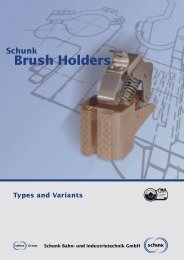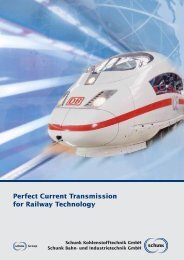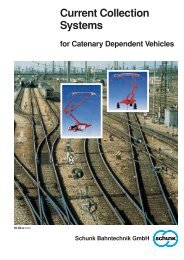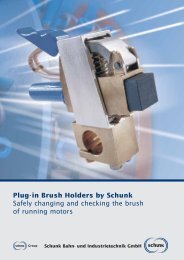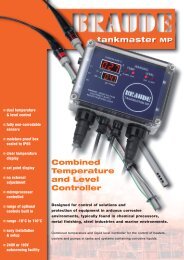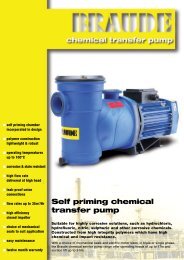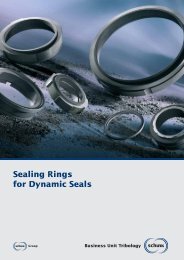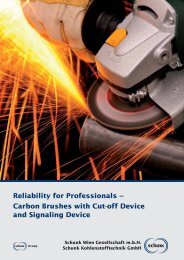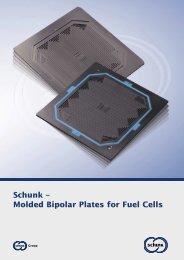Bearings
Bearings
Bearings
You also want an ePaper? Increase the reach of your titles
YUMPU automatically turns print PDFs into web optimized ePapers that Google loves.
Loading Capacity<br />
More than 70 running tests of at least<br />
500 h test period each have been<br />
necessary to obtain the values for<br />
one maximum loading curve. This is<br />
why these maximum loading curves<br />
are not available for all Schunk<br />
materials. However, supplementary<br />
tests have proved that the loading<br />
capacity of non-impregnated carbon<br />
graphite materials is significantly<br />
lower than that of materials impregnated<br />
with synthetic resins.<br />
speeds. The maximum sliding speed<br />
of 4.1 m/s in the p•v chart does not<br />
signify an application limit but was<br />
determined by the available test<br />
conditions.<br />
The maximum load curves in p · v<br />
chart 3 were determined for wet<br />
running radial bearings. Therefore,<br />
their validity for axial bearings is<br />
limited with respect to the design<br />
of such bearings and the amount<br />
of achievable hydro-dynamic<br />
lubrication.<br />
Axial bearings, except segmented<br />
axial bearings, should always be<br />
provided with lubricating grooves.<br />
The bearing porosity of the material<br />
has a decisive effect on the material<br />
loading ability as also has the<br />
material composition, strength and<br />
hardness. Particularly at higher<br />
porosities it can be observed that<br />
the influence of hydrodynamic<br />
lubrication decreases, especially<br />
with fluids exhibiting only a slight<br />
hydrodynamic lubrication effect, as<br />
a sufficient pressure in the clearance<br />
between bearing and shaft cannot<br />
be generated.<br />
specific load<br />
N/cm 2<br />
1000<br />
800<br />
600<br />
400<br />
-FH42A-<br />
-FH42Z2-<br />
Both impregnated materials (FH42Z2<br />
and FH42A) in the p•v chart 3<br />
have the same base material (FH42).<br />
If a more solid and harder basic<br />
material is selected (e.g. material<br />
FH82), higher loading capacities<br />
will be achieved with identical<br />
impregnaions.<br />
200<br />
1 2 3 4<br />
p•v diagram no. 3:<br />
Loading capacity of wet running carbon bearings as a function of sliding speed<br />
sliding speed<br />
m/s<br />
However, the use of these materials,<br />
such as FH82Z2 or FH82A, requires<br />
harder counterpart materials.<br />
The p•v chart 3 also shows that<br />
carbon bearings can be significantly<br />
higher loaded in wet running than in<br />
dry running conditions. Additionally,<br />
wet running carbon bearings can<br />
be applied at much higher sliding<br />
10




